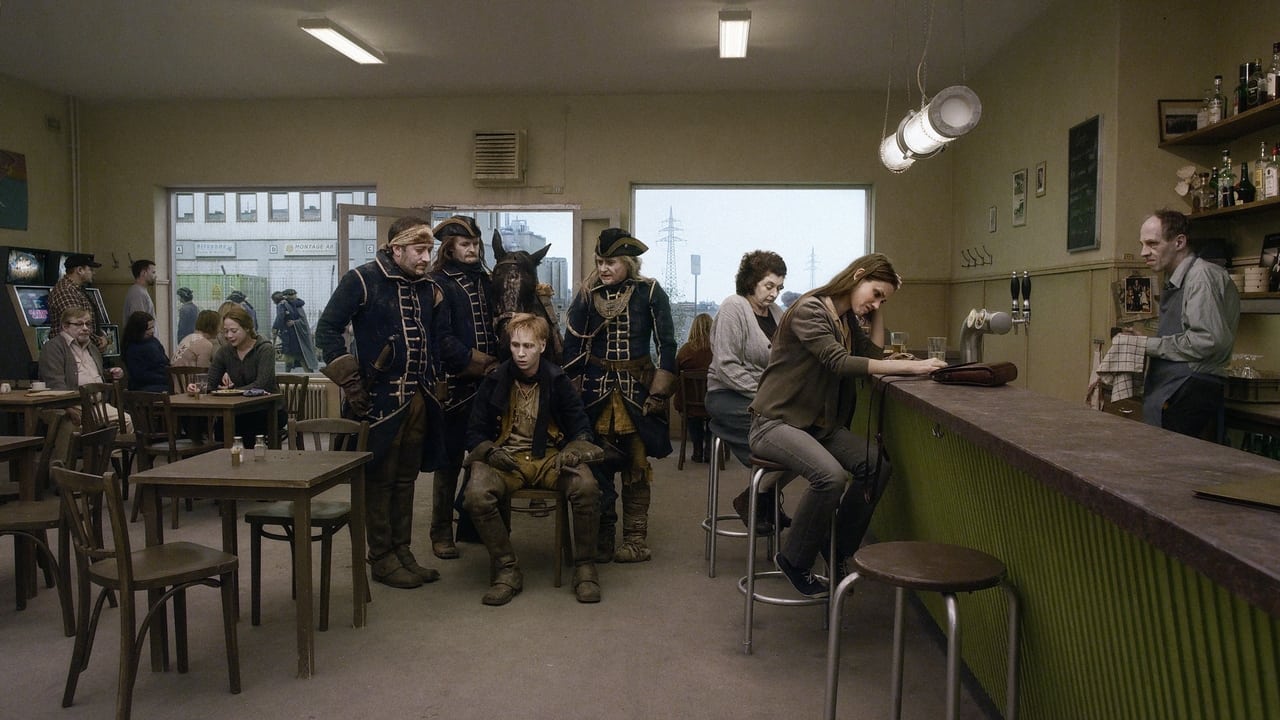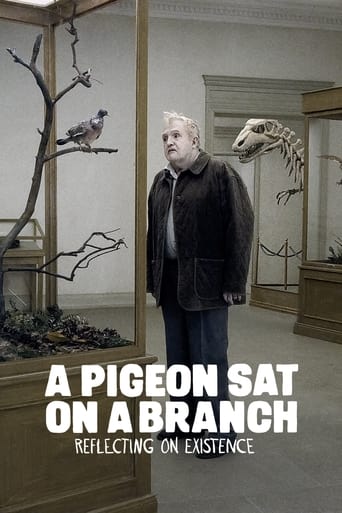

Pigeon is made in the same style as You, the Living. Again we have plenty of short scenes, shot from one angle, with no cuts. Filled with absurdity, no actual plot, various way of interpretation. Too deep or too obvious, Andersson bounces between two extremes. The characters and the scenes are overdrawn. Everything happens in one, slow pace. Silence is boring and dulling the vigilance. In comparison, You, the Living seemed more... lively.If Andersson shows Swedish society, I felt the criticism towards it in one scene, mocking it in the second and a direct reference to it in the third. The critique is present in a scene with elderly elegant Swedes observing the cruelty, done by non-Sweden. For me this is a reflection on Swedish neutrality in the 20th century. Mocking the Swedish society appears in the last scene. Bunch of people is waiting at the bus stop and one of the men starts to ask if today it's really Wednesday, cause for him it felt like Thursday. The group assures him that yes indeed, it's Wednesday. Additionally, the other man explains, that we all have to agree that it's Wednesday, otherwise there's gonna be chaos. Of course the first man did not imply that we wished it's another day of the week or that he is still gonna pretend it's not Wednesday. It did not hinder the other man to make sure that everything is clear - even if you feel like something else, you have to agree with everyone else in order to keep peace and organization. It might be exaggerated reference to Jantelagen (no one is special, no one should act like they are superior to one another). It is established that it's Wednesday, everyone has to adjust.And then it's my favourite scene with Charles XII. He, as a Swedish king, should be a clear indicator that Andersson tells something about Sweden. Okay, we have a king with absolute power, everyone serves him even if he has the most ridiculous demands. But... this could be any monarch, right? So for me by using him, the director was more about praising the modernization, understood both as moving from kingdoms to democracy and as equalization of the societies. Choosing Charles XII could simply just give Andersson space to mock king's homosexual needs, which was directly shown. Despite different possible interpretations, I admire Andersson for the technical management of this scene. It's the longest one in the movie and the most complicated. So many elements could go wrong and in the end there is this final version with no cut. Standing ovation.What if we look at Pigeon not as a portrait of Swedish life, but a life itself? All the feelings are phlegmatic. Even love, even anger, even laughter. Is the life so unfair or do we make it this way ourselves? I think that Swedish societ" is just a frame. Andersson is using some obvious cliches and stereotypes (which still can be true!) about his motherland in order to explain something more, something common to all human beings. Or I'm just trying to find deeper meaning which really isn't there. If so, this is just another proof of this director's strength - his movies can be seen through so many shades of interpretation.
... View MoreThe movie takes painstaking care to portray humanity at its worst. With thespian scenes, set camera and no movement, the unlucky viewer is led through a series of mostly disconnected tragedies of the mundane and less mundane life, with the actors generally mostly half-way to their grave both in agility and complexion. Lacking respect of death and the dying, death, greed, cruelty, slavery, torture, poverty, heart-break, loneliness, depression, suicide, war, grief. There is no character development, no hope, no love, no colour. In a regrettably dystopian image of a world, Andersson is treating the audience to misery and despair, without bothering with too much imagination. Attempts of understated comedian expression repeatedly fall flat. The end credits come as a relief from utter boredom.
... View MoreA unique blend of bleak modernist drama, Pinter or Beckett maybe, and Benny Hill–style sketch comedy, with more than a dash of Edvard Munchian gloom. Andersson's one of those one-of-a-kind directors like Tati or Buñuel; this is the first of his films we've seen, and we were immediately captivated. Even the aggressively ugly sets, the static camera and the grotesque puttylike makeup struck me as LOL funny for some reason. The short sketches don't really build on what's gone before; the film just slowly winds down to an abrupt fadeout. Having said that though, I sat there quite happily, like a pigeon on a branch, for the whole 101′. There are a few recurring characters—notably the two mopey "novelty item" salesmen, whom I started to find quite endearing—and two Pythonesque set pieces: Sweden's 18th-c. gay warrior-king, Charles XII, stops off at a modern dive bar both before and after his disastrous Russian campaign, and pith-helmeted Brits reenact the creepy ancient legend of the brazen bull (an infernal machine that transformed the screams of its victims into what the CC calls "soft harmonious music"). As with much of Wes Anderson's work, I didn't totally get it, but I appreciated the effort. I was happy to get back to the two sad-sack salesmen though, and I wished them success in their next day's rounds.
... View MoreIn 1877 John Ruskin famously said of a painting by James Whistler that he was "flinging a pot of paint in the public's face" when dismissing it as not being art.My reaction to this film is quite similar. Yes, it's a film in the sense that it's a sequence of scenes intended to be viewed on a screen. Also, I suppose Roy Andersson believes he's making an important point about something - the banality of Man's inhumanity to Man, perhaps - with it. However, the idea that a running joke that is not funny, is itself funny, is not funny; or, at least, it's not funny in Andersson's hands. This nominally absurdist film is turgid, mirthless and all but featureless. It's extremely slow-paced, deliberately so.Consequently, it seems to me that Andersson has made a kind of "anti-film" as a metaphor for people's lack of empathy for each other. In doing so, he has completely defeated his own purpose as it's likely none but a very small minority of people could find much of worth in such a boring (non-)film.Almost as if Andersson lost conviction in his approach, towards the end of this assemblage of flat scenes there is a pair that, although shot in the same low-key style, are nasty. It's hard to avoid the impression that Andersson thought he had better do something unsubtle to make his audience understand that he appears to draw some moral equivalence between an everyday lack of empathy between people and more heinous acts.So we come back to Ruskin; whatever this effort is, I don't think it's a film. Does it have some other importance? I don't think so.
... View More